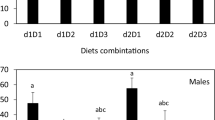Abstract
The development of the red palm weevil, Rhynchophorus ferrugineus (Olivier) was investigated on a newly developed semiartificial diet as compared with two natural diets namely sugarcane stem and banana fruit. The weevil was successfully maintained on these diets and duration of the life cycle for males and females, respectively were 164.97 and 194.61 days on the semiartificial diet, 192.5 and 186.5 days on banana, and 172.00 and 170.00 days on sugarcane. The average egg production per female was shown to be significantly higher on the semiartificial diet, being 184.00 ± 18.68 eggs compared with an average of 125.00 ± 11.97 and 133.00 ± 15.21 eggs on banana and sugarcane, respectively. The fertility ranged between 94 – 100 % in those eggs deposited by females previously reared on the tested diets. The developed semiartificial diet was shown to be suitable for maintaining laboratory colonies of the red palm weevil, and it can substitute natural diets.
Similar content being viewed by others
Author information
Authors and Affiliations
Rights and permissions
About this article
Cite this article
Salama, H., Abdel-Razek, A. Development of the red palm weevil, Rhynchophorus ferrugineus (Olivier), (Coleoptera, Curculionidae) on natural and synthetic diets. Anzeiger für Schädlingskunde/J. Pest Science 75, 137–139 (2002). https://doi.org/10.1046/j.1472-8206.2002.02039.x
Issue Date:
DOI: https://doi.org/10.1046/j.1472-8206.2002.02039.x




